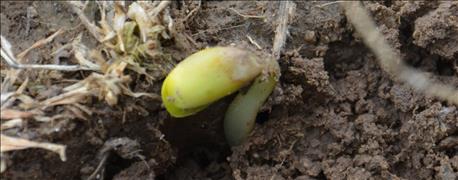
Hopefully, your soybeans are up and off to a great start. If there is a field or two where plants are struggling, here is a four-step process to determine what might be causing early-season problems.
Pictures used to illustrate these steps are from a real field where the farmer found stand issues. Some soybeans were emerging late, some were dying after emergence and some never emerged properly.
Information for these steps comes from the Purdue University Corn & Soybean Field Guide. It’s prepared and distributed by the Purdue Diagnostic Training Center, headed by Corey Gerber.

PICK OUT SEEDLINGS IN TROUBLE: The first step is to locate seedlings which are slow in emerging and which don’t appear healthy.
1. Identify seedlings slow to emerge.
Many seedlings were already up and developing trifoliate leaves while this seedling and several others were still trying to emerge. Note that the cotyledon is somewhat swollen and off-color. Since there were several seedlings similar to this one scattered across the field, the farmer elected to investigate further to see what was affecting these seedlings.
2. Dig abnormal plants and examine roots.

Insects like seed corn maggot can chew through seedlings. This seedling shows no signs of insect damage. However, there is minimal root development so far on this plant. That can be a clue that something is affecting rooting establishment early in the season.
3. Compare the affected seedling with the more normal seedling.

Sacrifice a few normal seedlings by digging them up and comparing them to affected seedlings. Is the stem swollen more on one than another? Does one have more root development than the other? The goal here is to determine what is different about the seedling which is having difficulty getting the cotyledons above the ground so that normal growth and development can occur.
4. Evaluate stand with hula hoop to determine remaining population.

In this case part of the problem was determining which seedlings within the hula hoop would still grow and produce a contributing plant, and which were so damaged that they might be stunted, even if they did survive.
In this case, the farmer took stand counts and determined that he had about 90,000 plants per acre in this field. He left the stand and it produced good yield, he reported last fall.
As to what was impacting the seedlings, he tracked it to a herbicide application. The chemicals he used combined with extremely wet conditions in his area led to germination issues with some of the seedlings. He adjusted his weed control program for 2016 so that he used a different combination of herbicides, with fewer overall chances for producing herbicide injury.
About the Author(s)
You May Also Like




